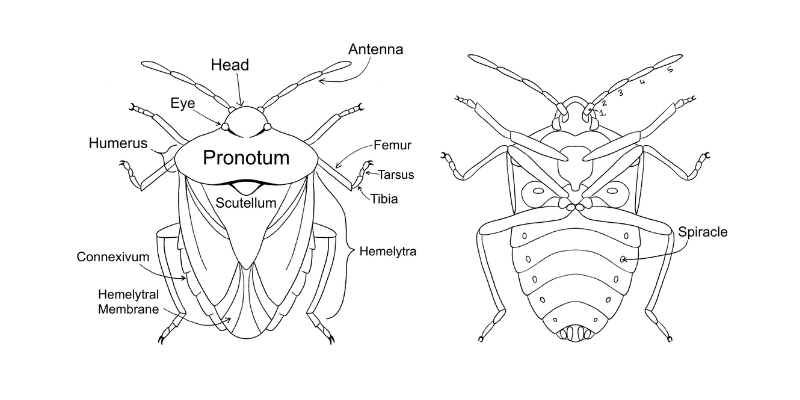
Under the magnifying glass: Shield bugs
Shield bugs are large insects that are relatively easy to spot basking on leaves in the sun. Their name refers to their shape, which resembles a medieval shield. Sadly, these invertebrates are declining. The latest State of Nature report found that our predatory invertebrates have decreased by 40% in England since the 1970s, however five types of shield bug can be found in the Forest.
What are shield bugs?
Shield bugs are a familiar insect, with their triangular bodies and shield-like patterns and shapes on their backs. Shield bugs (suborder: heteropteran) are from the hemiptera order, commonly called ‘true bugs’, alongside aphids, cicadas and planthoppers. True bugs are defined by their wing structure, number of legs, and sucking mouthparts. True bugs have modified mandibles, having a needle like mouthpart instead of biting mandibles.
Hemiptera means half wing in Greek, referring to the wing structure of true bugs. True bugs wings are hardened near the base and membranous towards the end. This differs from beetles, which have a completely hardened wing covering. Finally, all true bugs have three pairs of legs.
There are 46 species in the UK, but in this article, we will discuss how to identify five of these insects which can be found in the Forest.
Anatomy of shield bugs

The lifecycle of shield bugs*

Unlike butterflies, moths, and beetles, shield bugs do not have a pupa stage. Instead, these insects go through numerous shedding stages, known as ‘instars'.
Adult female shield bugs lay around 20-30 clusters of eggs in late April to early May, potentially laying hundreds of eggs. The eggs are green or yellow, oval-shaped, and are laid on the underside of leaves and plant stems. These eggs will hatch as nymphs around May time.
These nymphs will then go through five ‘moults’ (instars) throughout the summer, as the shield bug outgrows is exoskeleton. Finally, in autumn, after five sheds, the shield bugs are adults. At the adult stage, the shield bug has its wings and is sexually mature. The adults will then find a spot to hibernate throughout winter until springtime. In April, the adults re-emerge and mate, mating usually only once per year.
Five shield bugs to look out for in the Forest
1. Hawthorn shield bug (Acanthosoma haemorrhoidale)

When to see: April to October.
Identification features: This is our largest shield bug, measuring around 17mm in length. It is covered in lots of small black dots and has pointed ‘shoulders’ and red-brown wings. The red-brown wings can look like an ‘X’ shape on the back of the insect.
Where to find: On hawthorn. The nymphs feed on ripening berries of the hawthorn tree. They also eat rowan and whitebeam berries. Adults on the other hand feed on hawthorn leaves, a habit that earned the species its name.
Status: Nationally Common.
2. Hairy shield bug (Dolycoris baccarum)

When to see: January to December.
Identification features: A purplish brown shield bug (on its pronotum and hemelytra) with a greenish triangular path on the centre of its back (scutellum). Hairy shield bugs have a black and white, banded/chequered boarder around the body and antennae. If you also look close enough, you can see that the entire body of the invertebrate is covered in fine hairs.
Where to find: Usually found near blackthorn due to feeding on the sloe berries and blackthorn leaves. Hairy shield bugs also feed on other plants, meaning this species is often found within dry, botanically rich grasslands.
Status: Locally Common.
3. Tortoise shield bug (Eurygaster testudinaria)

When to see: January to December.
Identification features: Large, up to 11m in length. The head of the tortoise shield bug is much broader than other species, having less of a depression between the head and the thorax (pronoytum). The scutellum is broad and goes to the end of the abdomen, covering the membranous wings. Overall, it is a sandy brown colour, with a chequered pattern around the edge of the abdomen.
Where to find: Usually on dry grasslands, on seed heads of long grass.
Status: Scattered.
4. Blue shield bug (Zicrona caerulea)

When to see: January to December.
Identification features: A medium-sized (up to 7mm in length) dark shield bug with a deep blueish green, metallic sheen and a darker than usual wing membrane.
Where to find: This species is predatory, feeding blue flea-beetles and other leaf beetles. Due to this, this shield bug is usually found in damp grasslands and woodland rides, low amongst the vegetation.
Status: Scattered.
5. Red-legged shield bug (Forest bug, Pentatoma rufipes)

When to see: July to November.
Identification features: The red-legged shield bug is one of three brown shield bugs with shoulder 'spikes'. It is best identified by its square-cut shoulders and black-and-cream-chequered flanks. It has orangey-red legs and antennae.
Where to find: Usually found in woodlands, on oak and elm.
Status: Common and widespread.
Benefit to the ecosystem
Shield bugs are both herbivorous and predatory. Some species, such as the blue shield bug (Zicrona caerulea), purely eat other small invertebrates, some which are considered pests in crops and in gardens.
As well as being a predator, other species predate on these insects, such as spiders, centipedes, and small mammals.
Why do shield bugs matter?
The latest State of Nature report 2023 reported that in England our predatory invertebrates have decreased by 40% since 1970. This means that ‘pest’ invertebrates on crops and other vegetation can increase, making people more reliant on pesticides to counteract this.
Report your findings!
Spotted any of these in the Forest? Contact Avery to report your findings.



